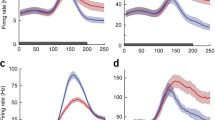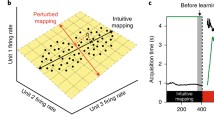Abstract
We demonstrate that equipping the neurons of Fukushima's neocognitron with the phenomenon that a neuron decreases its activity when repeatedly stimulated (adaptation) markedly improves the pattern discriminatory power of the network. By means of adaptation, circuits for extracting discriminating features develop preferentially. In the original neocognitron, in contrast, features shared by different patterns are preferentially learned, as connections required for extracting them are more frequently reinforced.
Similar content being viewed by others
References
Barnard E, Casasent D (1990) Shift invariance and the neocognitron. Neural Networks 3:403–410
Carpenter G, Grossberg S (1987) Art2:stable self-organization of pattern recognition codes for analog input patterns. Appl Opt 26:4919–4930
Connors B, Gutnick MJ, Prince DA (1982) Electrophysiological properties of neocortical neurons in vitro. J Neurophysiol 48:1302–1320
De Boer RJ (1989) Clonal selection versus idiotypic network models of the immune system. Thesis, University of Utrecht, The Netherlands, p 6
Desimone R (1992) The physiology of memory: recordings of things past. Science 258:245–246.
Fukushima K (1980) Neocognitron: a self-organising neural network for a mechanism of pattern recognition unaffected by shift in position. Biol Cybern 36:193–202.
Fukushima K (1988) Neocognitron: a hierarchical neural network capable of visual pattern recognition. Neural Networks 1:119–130
Fukushima K (1989) Analysis of the process of visual pattern recognition by the neocognitron. Neural Networks 2:413–420
Fukushima K, Imagawa T (1993) Recognition and segmentation of connected characters with selective attention. Neural Networks 6:33–41
Fukushima K, Myake S (1982) Neocognitron: a new algorithm for pattern recognition tolerant of deformations and shifts in position. Pattern Recognition 15:455–469
Hubel DH, Wiesel TN (1962) Receptive fields, binocular interaction and functional architecture in cat's visual cortex. J Physiol (Lond) 160:106–154
Hubel DH, Wiesel TN (1965) Receptive fields and functional architecture in two nonstriate visual area (18 and 19) of the cat. J Neurophysiol 28:229–289
Kohonen T (1984) Self-organization and associative memory. Springer, New York Berlin Heidelberg
Kohonen T (1992) Artifical neural networks: models, paradigms or methods? In: Aleksander I, Taylor J (eds) Artificial neural networks, vol 1. Proceedings of ICANN-92. Elsevier, Amsterdam, pp 3–10
Meech RW (1978) Calcium-dependent potassium activation in nervous tissues. Annu Rev Biophys Bioeng 7:1–18
Menon MM, Heinemann KG (1988) Classification of patterns using a self-organizing neural network. Neural Networks 1:201–215
Miller EK, Li L, Desimone R (1991) A neural mechanism for working and recognition memory in inferior temporal cortex. Science 254:1377–1379
Miyake S, Fukushima K (1984) A neural network model for the mechanism of feature-extraction, a self-organizing network with feedback inhibition. Biol Cybern 50:377–384
Reilly DL, Cooper LN, Elbaum C (1982) A neural model for category learning. Biol Cybern 45:35–41
Rolls ET, Miyashita Y, Cahusac PMB, Kesner RP, Niki H, Feigenbaum JD, Bach L (1989) Hippocampal neurons in the monkey with activity related to the palce in which a stimulus is shown. J. Neurosci. 9:1835–1845
Selverston AI (1988) A consideration of invertebrate central pattern generators as computational data bases. Neural Networks 1:109–117
Traub RD (1982) Simulation of intrinsic bursting in CA3 hippocampal neurons. Neuroscience 7:1233–1242
Trotin A, Darbel N, Jutand F (1991) Acquired structure, adapted parameters: modifications of the Neocognitron. In: Aleksander I, Taylor J (eds) Artificial neural networks, vol 2. Proceedings of ICANN-92. Elsevier, Amsterdam, pp 1107–1110
Author information
Authors and Affiliations
Rights and permissions
About this article
Cite this article
van Ooyen, A., Nienhuis, B. Pattern recognition in the neocognitron is improved by neuronal adaptation. Biol. Cybern. 70, 47–53 (1993). https://doi.org/10.1007/BF00202565
Received:
Accepted:
Issue Date:
DOI: https://doi.org/10.1007/BF00202565




